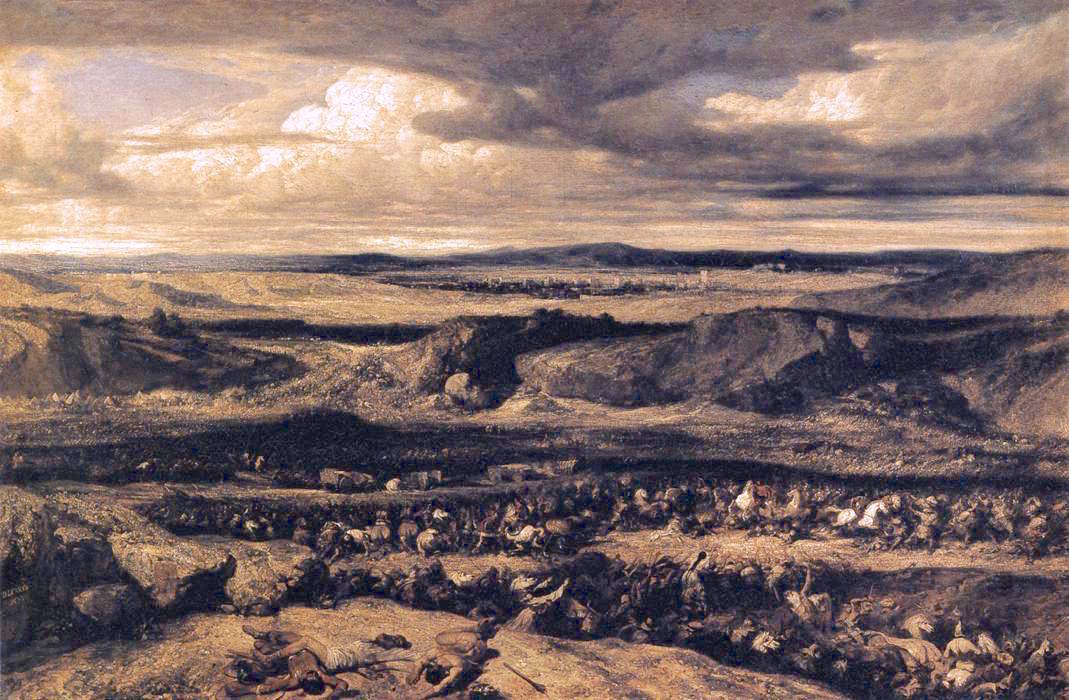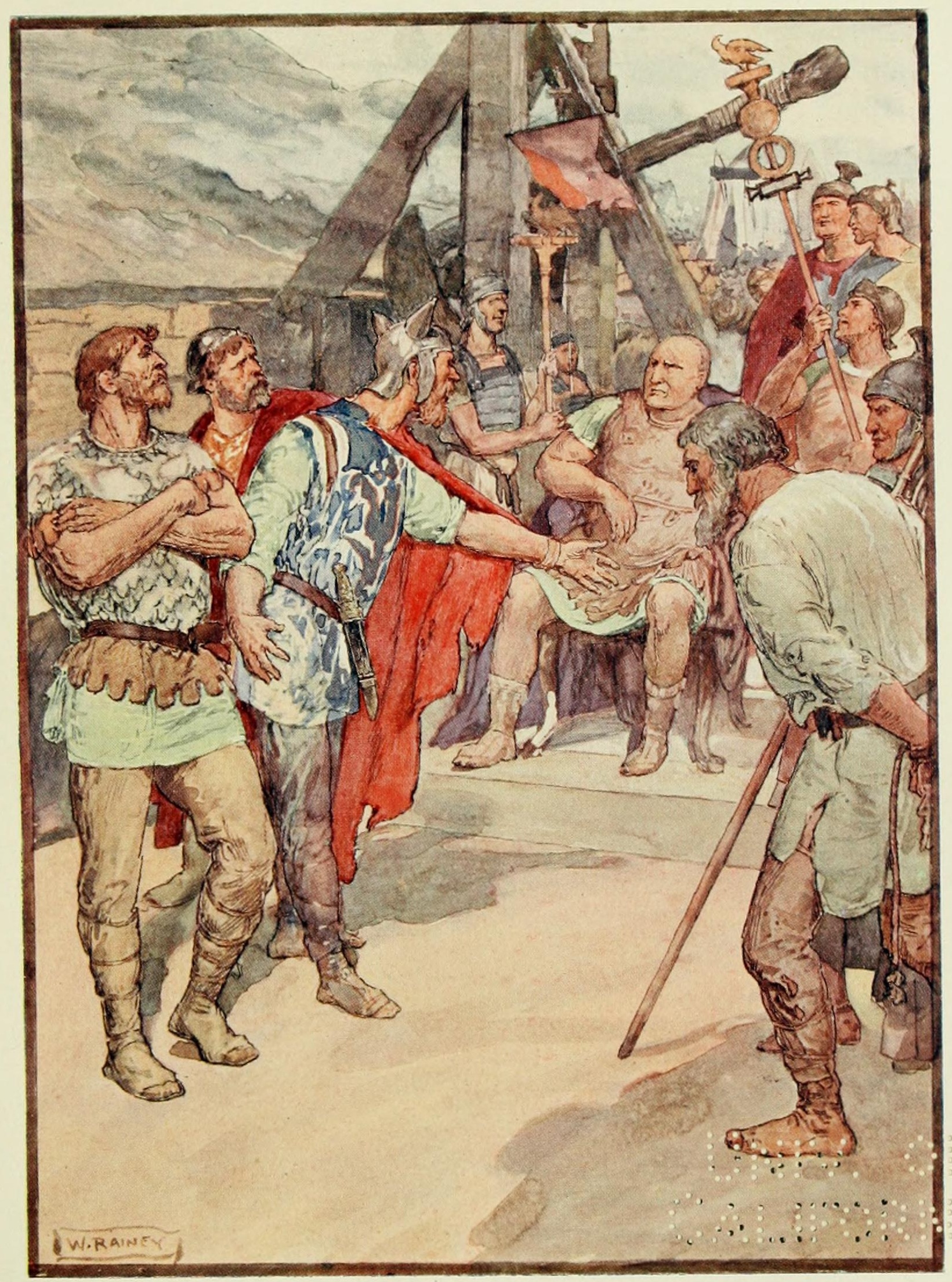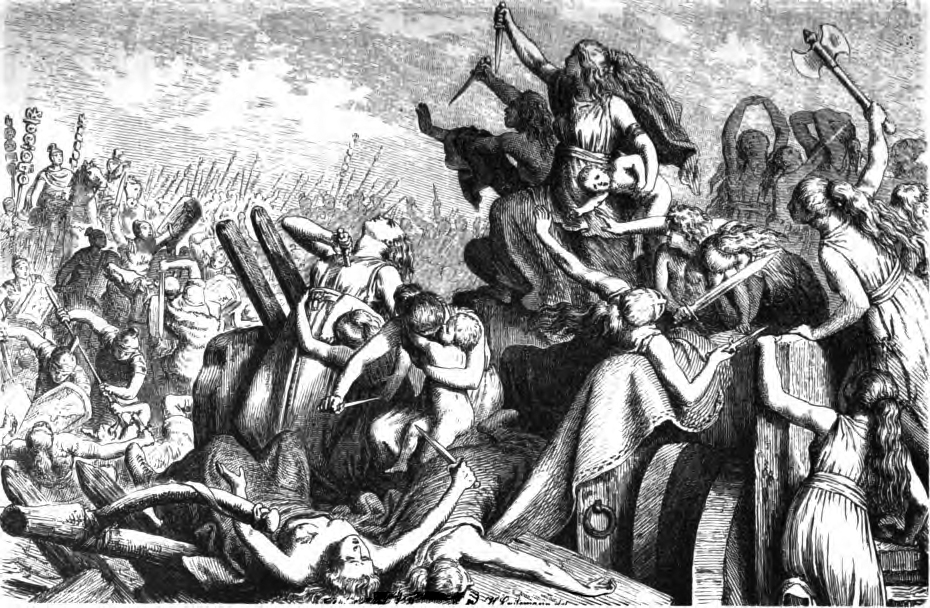|
Cimbri
The Cimbri (Greek Κίμβροι, ''Kímbroi''; Latin ''Cimbri'') were an ancient tribe in Europe. Ancient authors described them variously as a Celtic people (or Gaulish), Germanic people, or even Cimmerian. Several ancient sources indicate that they lived in Jutland, which in some classical texts was called the Cimbrian peninsula. There is no direct evidence for the language they spoke, though some scholars argue that it must have been a Germanic language, while others argue that it must have been Celtic. Together with the Teutones and the Ambrones, they fought the Roman Republic between 113 and 101 BC during the Cimbrian War. The Cimbri were initially successful, particularly at the Battle of Arausio, in which a large Roman army was routed. They then raided large areas in Gaul and Hispania. In 101 BC, during an attempted invasion of the Italian peninsula, the Cimbri were decisively defeated at the Battle of Vercellae by Gaius Marius, and their king, Boiorix, was killed. So ... [...More Info...] [...Related Items...] OR: [Wikipedia] [Google] [Baidu] |
Battle Of Vercellae
The Battle of Vercellae, or Battle of the Raudine Plain, was fought on 30 July 101 BC on a plain near Vercellae in Gallia Cisalpina (modern day Northern Italy). A Germanic-Celtic confederation under the command of the Cimbric king Boiorix was defeated by a Roman army under the joint command of the consul Gaius Marius and the proconsul Quintus Lutatius Catulus. The battle marked the end of the Germanic threat to the Roman Republic. Background In 113 BC, a large migrating Germanic-Celtic alliance headed by the Cimbri and the Teutones entered the Roman sphere of influence. They invaded Noricum (located in present-day Austria and Slovenia) which was inhabited by the Taurisci people, friends and allies of Rome. The Senate commissioned Gnaeus Papirius Carbo, one of the consuls, to lead a substantial Roman army to Noricum to force the barbarians out. An engagement, later called the battle of Noreia, took place, in which the invaders completely overwhelmed the Roman Legions and inf ... [...More Info...] [...Related Items...] OR: [Wikipedia] [Google] [Baidu] |
Cimbrian War
The Cimbrian or Cimbric War (113–101 BC) was fought between the Roman Republic and the Germanic and Celtic tribes of the Cimbri and the Teutons, Ambrones and Tigurini, who migrated from the Jutland peninsula into Roman controlled territory, and clashed with Rome and her allies. The Cimbrian War was the first time since the Second Punic War that Italia and Rome itself had been seriously threatened. The timing of the war had a great effect on the internal politics of Rome, and the organization of its military. The war contributed greatly to the political career of Gaius Marius, whose consulships and political conflicts challenged many of the Roman Republic's political institutions and customs of the time. The Cimbrian threat, along with the Jugurthine War, inspired the landmark Marian reforms of the Roman legions. Rome was finally victorious, and its Germanic adversaries, who had inflicted on the Roman armies the heaviest losses that they had suffered since the Second Punic Wa ... [...More Info...] [...Related Items...] OR: [Wikipedia] [Google] [Baidu] |
Gaius Marius
Gaius Marius (; – 13 January 86 BC) was a Roman general and statesman. Victor of the Cimbric and Jugurthine wars, he held the office of consul an unprecedented seven times during his career. He was also noted for his important reforms of Roman armies. He set the precedent for the shift from the militia levies of the middle Republic to the professional soldiery of the late Republic; he also improved the '' pilum'', a javelin, and made large-scale changes to the logistical structure of the Roman army. Rising from a well-off provincial Italian family in Arpinum, Marius acquired his initial military experience serving with Scipio Aemilianus at the Siege of Numantia in 134 BC. He won election as tribune of the plebs in 119 BC and passed a law limiting aristocratic interference in elections. Barely elected praetor in 115 BC, he next became the governor of Further Spain where he campaigned against bandits. On his return from Spain he married Julia, the aunt of J ... [...More Info...] [...Related Items...] OR: [Wikipedia] [Google] [Baidu] |
Battle Of Arausio
The Battle of Arausio took place on 6 October 105 BC, at a site between the town of Arausio (now Orange, Vaucluse), and the Rhône River. Ranged against the migratory tribes of the Cimbri under Boiorix and the Teutoni under Teutobod were two Roman armies, commanded by the proconsul Quintus Servilius Caepio and consul Gnaeus Mallius Maximus. However, bitter differences between the commanders prevented the Roman armies from co-operating, with devastating results. The terrible defeat gave Gaius Marius the opportunity to come to the fore and make radical reforms to the organisation and the recruitment of Roman legions. Roman losses are described as being up to 80,000 troops as well as another 40,000 auxiliary troops ( allies) and servants and camp followers – 120,000 in total, virtually all of their participants in the battle. In terms of losses, the battle is regarded as one of the worst defeats in the history of ancient Rome. Even surpasssing the devastating Battle of Cann ... [...More Info...] [...Related Items...] OR: [Wikipedia] [Google] [Baidu] |
Teutones
The Teutons ( la, Teutones, , grc, Τεύτονες) were an ancient northern European tribe mentioned by Roman authors. The Teutons are best known for their participation, together with the Cimbri and other groups, in the Cimbrian War with the Roman Republic in the late second century BC. Julius Caesar described them as a Germanic people, a term he applied to all northern peoples located east of the Rhine, and later Roman authors followed him. On one hand, there is no direct evidence that they spoke a Germanic language, and evidence such as their name, and the names of their rulers, indicates at least a strong influence from Celtic languages. On the other hand the indications that classical authors gave about the homeland of the Teutones is considered by many scholars to show that they lived in an area associated with early Germanic languages, and not Celtic languages. Name The ethnonym is attested in Latin as ''Teutonēs'' or ''Teutoni'' (plural) or, more rarely, as ''Teut ... [...More Info...] [...Related Items...] OR: [Wikipedia] [Google] [Baidu] |
Ambrones
The Ambrones ( grc, Ἄμβρωνες) were an ancient tribe mentioned by Roman authors. They are generally believed to have been a Germanic tribe from Jutland. In the late 2nd century BC, along with the fellow Cimbri and Teutons, the Ambrones migrated from their original homes and invaded the Roman Republic, winning a spectacular victory at the Battle of Arausio in 105 BC. The Ambrones and the Teutons, led by Teutobod, were eventually defeated at the Battle of Aquae Sextiae in 102 BC. Name The origin of the name ''Ambrones'' poses a great difficulty in explanation, since the root ''Ambr''- and its variants are found in many areas of the European continent: the Ombrones of the upper Vistula, the *Ymbre (dat. ''Ymbrum''), a tribe mentioned in the ''Widsith'', the islands of Amrum (older ''Ambrum'') and Imbria (modern Fehmarn), the river names Ammer, Amper, and Emmer, the region of Ammerland, the town of Emmerich, as well as the Italic Umbri (or ''Ombrii'') and the Greek person ... [...More Info...] [...Related Items...] OR: [Wikipedia] [Google] [Baidu] |
Jutland
Jutland ( da, Jylland ; german: Jütland ; ang, Ēota land ), known anciently as the Cimbric or Cimbrian Peninsula ( la, Cimbricus Chersonesus; da, den Kimbriske Halvø, links=no or ; german: Kimbrische Halbinsel, links=no), is a peninsula of Northern Europe that forms the continental portion of Denmark and part of northern Germany. The names are derived from the Jutes and the Cimbri, respectively. As with the rest of Denmark, Jutland's terrain is flat, with a slightly elevated ridge down the central parts and relatively hilly terrains in the east. West Jutland is characterised by open lands, heaths, plains, and peat bogs, while East Jutland is more fertile with lakes and lush forests. Southwest Jutland is characterised by the Wadden Sea, a large unique international coastal region stretching through Denmark, Germany, and the Netherlands. Geography Jutland is a peninsula bounded by the North Sea to the west, the Skagerrak to the north, the Kattegat and Baltic Sea to the ... [...More Info...] [...Related Items...] OR: [Wikipedia] [Google] [Baidu] |
Cimmerian
The Cimmerians (Akkadian: , romanized: ; Hebrew: , romanized: ; Ancient Greek: , romanized: ; Latin: ) were an ancient Eastern Iranian equestrian nomadic people originating in the Caspian steppe, part of whom subsequently migrated into West Asia. Although the Cimmerians were culturally Scythian, they formed an ethnic unit separate from the Scythians proper, to whom the Cimmerians were related and who displaced and replaced the Cimmerians.: "As the Cimmerians cannot be differentiated archeologically from the Scythians, it is possible to speculate about their Iranian origins. In the Neo-Babylonian texts (according to D’yakonov, including at least some of the Assyrian texts in Babylonian dialect) and similar forms designate the Scythians and Central Asian Saka, reflecting the perception among inhabitants of Mesopotamia that Cimmerians and Scythians represented a single cultural and economic group" The Cimmerians themselves left no written records, and most information about the ... [...More Info...] [...Related Items...] OR: [Wikipedia] [Google] [Baidu] |
Cimmerians
The Cimmerians (Akkadian: , romanized: ; Hebrew: , romanized: ; Ancient Greek: , romanized: ; Latin: ) were an ancient Eastern Iranian equestrian nomadic people originating in the Caspian steppe, part of whom subsequently migrated into West Asia. Although the Cimmerians were culturally Scythian, they formed an ethnic unit separate from the Scythians proper, to whom the Cimmerians were related and who displaced and replaced the Cimmerians.: "As the Cimmerians cannot be differentiated archeologically from the Scythians, it is possible to speculate about their Iranian origins. In the Neo-Babylonian texts (according to D’yakonov, including at least some of the Assyrian texts in Babylonian dialect) and similar forms designate the Scythians and Central Asian Saka, reflecting the perception among inhabitants of Mesopotamia that Cimmerians and Scythians represented a single cultural and economic group" The Cimmerians themselves left no written records, and most information about t ... [...More Info...] [...Related Items...] OR: [Wikipedia] [Google] [Baidu] |
Germanic Peoples
The Germanic peoples were historical groups of people that once occupied Central Europe and Scandinavia during antiquity and into the early Middle Ages. Since the 19th century, they have traditionally been defined by the use of ancient and early medieval Germanic languages and are thus equated at least approximately with Germanic-speaking peoples, although different academic disciplines have their own definitions of what makes someone or something "Germanic". The Romans named the area belonging to North-Central Europe in which Germanic peoples lived ''Germania'', stretching East to West between the Vistula and Rhine rivers and north to south from Southern Scandinavia to the upper Danube. In discussions of the Roman period, the Germanic peoples are sometimes referred to as ''Germani'' or ancient Germans, although many scholars consider the second term problematic since it suggests identity with present-day Germans. The very concept of "Germanic peoples" has become the subject of ... [...More Info...] [...Related Items...] OR: [Wikipedia] [Google] [Baidu] |
Boiorix
Boiorix was a king of the Cimbri tribe during the Cimbrian War. His most notable achievement was the victory against the Romans at the Battle of Arausio in 105 BC. He was later defeated and slain along with Lugius at the Battle of Vercellae in 101 BC. The other Cimbrian chiefs Claodicus Claodicus was a co-leader of the Cimbri tribe during the Cimbrian War, in which the Cimbri won a spectacular victory against the Romans at the Battle of Arausio in 105 BC. He was captured along with Caesorix at the Battle of Vercellae in 101 BC. ... and Caesorix were captured. References 101 BC deaths Cimbrian people Military personnel killed in action People of the Cimbrian War Pre-Roman Iron Age Year of birth unknown 2nd-century BC monarchs {{Rome-stub ... [...More Info...] [...Related Items...] OR: [Wikipedia] [Google] [Baidu] |
Roman Republic
The Roman Republic ( la, Res publica Romana ) was a form of government of Rome and the era of the classical Roman civilization when it was run through public representation of the Roman people. Beginning with the overthrow of the Roman Kingdom (traditionally dated to 509 BC) and ending in 27 BC with the establishment of the Roman Empire, Rome's control rapidly expanded during this period—from the city's immediate surroundings to hegemony over the entire Mediterranean world. Roman society under the Republic was primarily a cultural mix of Latin and Etruscan societies, as well as of Sabine, Oscan, and Greek cultural elements, which is especially visible in the Roman Pantheon. Its political organization developed, at around the same time as direct democracy in Ancient Greece, with collective and annual magistracies, overseen by a senate. The top magistrates were the two consuls, who had an extensive range of executive, legislative, judicial, military, and religious powers ... [...More Info...] [...Related Items...] OR: [Wikipedia] [Google] [Baidu] |





